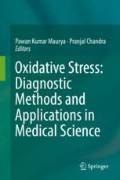Abstract
Oxidative stress is well-known phenomenon, caused by a shift in the delicate balance between radical generation and scavenging of radical capacity in cells. Reactive oxygen species (ROS) primarily composed of superoxide radicals, hydroxyl radicals, etc. In principle, every molecule including oxygen is known as an oxidant or oxidizing agent if it is capable of accepting electrons (Prior and Cao 1999), and the process of electron loss is known as oxidation. In biology, the process of oxidation is always accompanied by reduction and such reactions are called as redox reactions. Redox reactions are basis for numerous biochemical pathways including biosynthesis and regulation of metabolism. While oxidant and reductant are chemical terms, in biological context these are often known as pro-oxidant and antioxidant, respectively (Kohen and Nyska 2002). Pro-oxidant includes several radical and nonradical species (Halliwell 2006).
Access this chapter
Tax calculation will be finalised at checkout
Purchases are for personal use only
References
Antolovich M, et al. Methods for testing antioxidant activity. Analyst. 2002;127(1):183–98.
Apak R, et al. Antioxidant activity/capacity measurement. 2. Hydrogen atom transfer (HAT)-based, mixed-mode (electron transfer (ET)/HAT), and lipid peroxidation assays. J Agric Food Chem. 2016;64(5):1028–45.
Belguendouz L, Fremont L, Linard A. Resveratrol inhibits metal ion-dependent and independent peroxidation of porcine low-density lipoproteins. Biochem Pharmacol. 1997;53(9):1347–55.
Blainski A, Lopes G, de Mello J. Application and analysis of the Folin Ciocalteu method for the determination of the Total phenolic content from Limonium Brasiliense L. Molecules. 2013;18(6):6852.
Brand-Williams W, Cuvelier ME, Berset C. Use of a free radical method to evaluate antioxidant activity. LWT Food Sci Technol. 1995;28(1):25–30.
Halliwell B. Reactive species and antioxidants. Redox biology is a fundamental theme of aerobic life. Plant Physiol. 2006;141(2):312–22.
Kohen R, Nyska A. Oxidation of biological systems: oxidative stress phenomena, antioxidants, redox reactions, and methods for their quantification. Toxicol Pathol. 2002;30(6):620–50.
Miller NJ, et al. A novel method for measuring antioxidant capacity and its application to monitoring the antioxidant status in premature neonates. Clin Sci (Lond). 1993;84(4):407–12.
Prior RL, Cao G. In vivo total antioxidant capacity: comparison of different analytical methods. Free Radic Biol Med. 1999;27(11–12):1173–81.
Sanchez-Moreno C, Satue-Gracia MT, Frankel EN. Antioxidant activity of selected Spanish wines in corn oil emulsions. J Agric Food Chem. 2000;48(11):5581–7.
Wayner DD, et al. Quantitative measurement of the total, peroxyl radical-trapping antioxidant capability of human blood plasma by controlled peroxidation. The important contribution made by plasma proteins. FEBS Lett. 1985;187(1):33–7.
Wijewickreme AN, Kitts DD, Durance TD. Reaction conditions influence the elementary composition and metal chelating affinity of Nondialyzable model Maillard reaction products. J Agric Food Chem. 1997;45(12):4577–83.
Zhang J, Stanley RA, Melton LD. Lipid peroxidation inhibition capacity assay for antioxidants based on liposomal membranes. Mol Nutr Food Res. 2006;50(8):714–24.
Acknowledgements
Authors would like to acknowledge Anamika Gangwar, DST-INSPIRE fellow at Defence Institute of Physiology and Allied Sciences (DIPAS, DRDO), who kindly provided the figures of flow cytometry and fluorescence microscopy used in the chapter.
Author information
Authors and Affiliations
Corresponding author
Editor information
Editors and Affiliations
Rights and permissions
Copyright information
© 2017 Springer Nature Singapore Pte Ltd.
About this chapter
Cite this chapter
Arya, A., Ahmad, Y. (2017). Oxidative Stress Monitoring Using In Vitro Systems: Tools and Findings. In: Maurya, P., Chandra, P. (eds) Oxidative Stress: Diagnostic Methods and Applications in Medical Science. Springer, Singapore. https://doi.org/10.1007/978-981-10-4711-4_7
Download citation
DOI: https://doi.org/10.1007/978-981-10-4711-4_7
Published:
Publisher Name: Springer, Singapore
Print ISBN: 978-981-10-4710-7
Online ISBN: 978-981-10-4711-4
eBook Packages: Biomedical and Life SciencesBiomedical and Life Sciences (R0)

